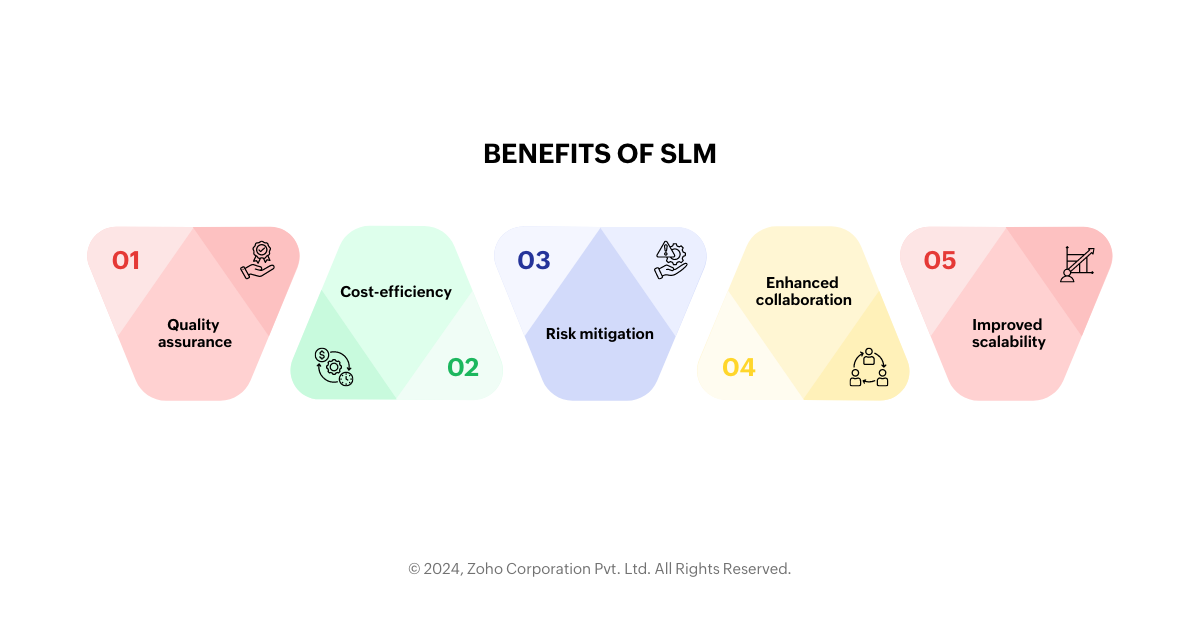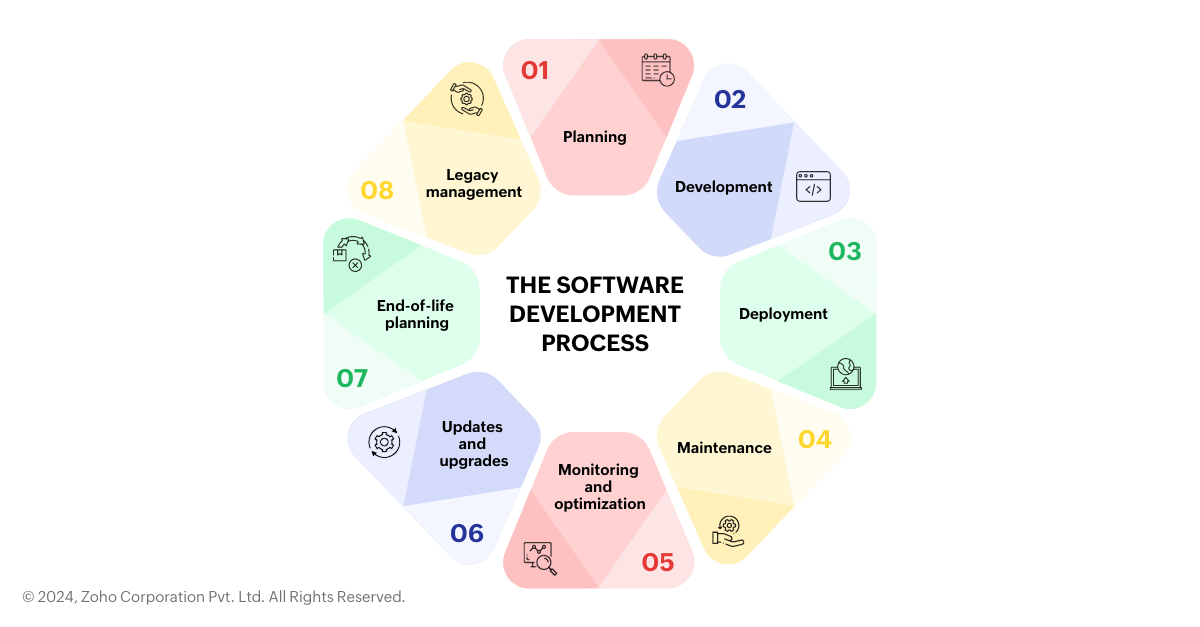- HOME
- Know Your Tech
- Everything you need to know about software lifecycle management and why it is important
Everything you need to know about software lifecycle management and why it is important
- Last Updated : March 17, 2025
- 2.5K Views
- 7 Min Read
According to a report by Verified Market Research, the SLM market size was "valued at USD 5.50 Billion in 2023 and is projected to reach USD 8.75 Billion by 2030, growing at a CAGR of 6.78% during the forecast period 2024-2030."
This is because development and management of software have become paramount for businesses across industries. As software plays a critical role in driving innovation, enhancing productivity, and delivering value to customers, it's essential to ensure that software applications are effectively managed throughout their entire lifecycle. This is where software lifecycle management (SLM) comes into play.
In this guide, we'll explore the intricacies of SLM, covering its definition, various models, stages, and the significance it holds in modern software development practices.
What is software lifecycle management?
SLM is a systematic approach to managing the entire product lifecycle, from its conception to its retirement. It consists of the strategic planning, development, deployment, maintenance, and eventual retirement of software products. SLM aims to optimize performance and longevity of software assets while ensuring alignment with organizational goals and user requirements.
Think of it as planning and building your dream home. You start with designing the blueprint and then construct the house. Once it's finished, you move in and take care of it with regular upkeep and repairs. Eventually, when you decide to sell or pass it on, you retire the house. Similarly, SLM guides the lifecycle of software applications from planning to retirement, ensuring it meets evolving needs.
SLM vs ALM: What's the difference?
While software lifecycle management and application lifecycle management (ALM) are related, they focus on different aspects of managing software.
SLM deals with the entire lifespan of software products—including applications, systems software, and other software components. It involves tasks such as initial planning and development, deployment, maintenance, quality assurance, and eventual retirement. SLM aims to ensure efficient and effective management of a software application throughout its lifecycle, regardless of its type or purpose.
In contrast, integrated application lifecycle management specifically focuses on managing applications from start to finish. It involves activities like requirements management, design, development, testing, deployment, and ongoing maintenance. ALM tools provide a standardized environment to address the unique challenges and complexities of application development and management.
Although both SLM and the ALM tools have their fair share of similarities and differences, it's important to note that they're crucial for organizations looking to optimize their software development and management processes, ensuring high-quality, reliable, and scalable software solutions to increase business value and meet evolving needs.
Types of SLM models
Each SLM model incorporates key features to accommodate various development needs and methodologies. Let's explore the distinct characteristics of each model:
Waterfall model
The waterfall model follows a sequential, linear approach to software development, where each phase of the application's lifecycle flows downward, like a waterfall. It typically consists of distinct stages—including requirements analysis, design, implementation, testing, deployment, and maintenance. While the waterfall model offers clarity and structure, it lacks flexibility and responsiveness to changing requirements.
Agile model
Iterative development, collaboration, and customer feedback are emphasized here. This model prioritizes adaptability and responsiveness to changing market demands, allowing for frequent iterations and incremental improvements through release management. Agile methodologies, such as Scrum and Kanban, promote close collaboration between cross-functional teams, rapid prototyping, and continuous integration and delivery (CI/CD).
DevOps model
The combination of software development (Dev) and IT operations (Ops) makes up DevOps, enabling seamless collaboration and automation across the entire software lifecycle. DevOps practices emphasize continuous integration, continuous delivery (CI/CD), infrastructure as code (IaC), and automated testing and deployment. By fostering a culture of collaboration and shared responsibility, DevOps aims to accelerate software delivery, enhance product quality, and improve overall efficiency.
Different stages of SLM
Effective software lifecycle management practices are paramount for delivering high-quality software solutions that not only meet user requirements but also align with overarching business objectives. Let's delve into the key stages of SLM to understand how each phase contributes to successful development project management, deployment, and maintenance of software solutions.
Planning
This stage of project management sets the cornerstone for a powerful SLM strategy, where project goals, scope, timelines, and resource requirements are defined through meticulous planning, including the breakdown of detailed tasks. Key activities include conducting feasibility studies, defining project objectives, identifying stakeholders, and creating a project roadmap. Effective initial project planning sets the stage for successful software development and ensures alignment of project status with business objectives.
Development
The coding, testing, and integration of software components makes up the development stage. Here, development teams collaborate closely to translate requirements into software solutions. Agile methodologies promote short development cycles, frequent source code iterations, and continuous feedback loops, allowing for rapid adaptation to changing requirements and market dynamics.
Deployment
In this stage, software is released into the production environment, making it available to end users. Depending on project requirements and the nature of the software, deployment and version control and strategies may vary, ranging from manual installations to automated deployments using CI/CD pipelines. Continuous monitoring, version control, test management and feedback are essential to identify and address any issues promptly.
Effective coordination between different teams, software development teams and operations teams is crucial to ensure software projects make a smooth transition from the development stage to production.
Maintenance
The maintenance stage involves ongoing support, updates, and enhancements to ensure the continued functionality and relevance of the software. Maintenance activities may include bug fixes, security patches, performance optimizations, source code management, and feature enhancements. Addressing issues and incorporating user feedback into the iterative development process helps organizations extend the lifespan of their software products while maximizing their value.
Monitoring and optimization
Software performance and usage metrics are continuously monitored to ensure optimal performance and resource utilization. This involves identifying bottlenecks, optimizing configurations, and scaling resources as needed to meet changing demands. By continuously monitoring and optimizing the whole requirements management and software environment, organizations can enhance user experience and minimize disruptions.
Updates and upgrades
As software evolves, updates and upgrades are necessary to introduce new features, address security vulnerabilities, and improve performance. This stage involves releasing patches, updates, and version upgrades in a timely manner to keep the software current and aligned with evolving requirements. Businesses can mitigate risks and maintain the integrity of their software solutions by staying on top of these updates.
End-of-life planning
Eventually, software reaches the end of its lifecycle and needs to be retired or decommissioned. This stage involves planning for the orderly shutdown of the software, including data migration, user communication, and transitioning to alternative solutions. End-of-life planning ensures a smooth transition while minimizing disruptions to users and business operations.
Legacy management
In some cases, organizations may have legacy software that continues to be used even after newer versions or alternatives are available. This stage involves managing legacy systems, including maintenance, support, and eventual retirement strategies. Legacy application management also ensures that older systems remain operational while gradually transitioning to modern solutions.
Why is SLM important?
Adopting SLM practices can benefit organizations immensely, offering advantages such as streamlined development processes, enhanced collaboration, and optimized resource allocation. Here are the numerous benefits that SLM brings to businesses.
Quality assurance
SLM practices help maintain high standards of software quality throughout the software lifecycle, ensuring it meets performance, reliability, and data security requirements. By implementing rigorous testing, full source code, reviews, and quality assurance processes, organizations can minimize defects and deliver a superior user experience.
Cost-efficiency
Organizations can optimize resource utilization, reduce development costs, and improve overall efficiency through a solid SLM strategy. Businesses can achieve cost savings while delivering high-quality software solutions on time and within budget by streamlining processes, eliminating redundancies, using project management tools and leveraging automation.
Risk mitigation
Risks associated with software development and deployment—including security vulnerabilities, compliance issues, and performance bottlenecks—can be mitigated with a well-planned SLM strategy. By adopting robust security measures, conducting regular audits, using compliance requirements and adhering to best practices, organizations can minimize the likelihood of security breaches and data loss.
Enhanced collaboration
SLM can be instrumental in collaboration and communication among cross-functional teams, including developers, testers, operations, and business stakeholders. Organizations can accelerate decision-making, foster innovation, and drive continuous improvement across the software development lifecycle by breaking down silos and promoting transparency.
Improved scalability
With effective SLM practices in place, organizations can scale their software solutions to accommodate growing user demands, market expansion, and evolving business requirements. By designing flexible architectures, modular components, and scalable infrastructure, businesses can future-proof their software investments and adapt to changing market conditions.

SLM is important for organizations seeking to maximize the value, performance, and longevity of their software assets. Adopting best practices, leveraging various methodologies, and embracing a culture of continuous improvement can help businesses streamline their development processes, enhance collaboration, and deliver innovative solutions that meet the needs of their stakeholders.
If you're in the market for a comprehensive solution to streamline your software development and product lifecycle management, check out Zoho Creator. As a user-friendly and cost-effective low-code platform, Zoho Creator empowers developers of all skill levels with the essential tools for effective SLM. With a solid SLM strategy in place, development teams can seamlessly navigate every stage of software development, delivery, and management, with enhanced efficiency and productivity throughout the process.
 Stephen
StephenStephen is a product marketer at Zoho Creator. An avid writer, he plies his trade evangelizing low-code during the day and pens songs at night. Sneakerhead and sushi enthusiast too.




